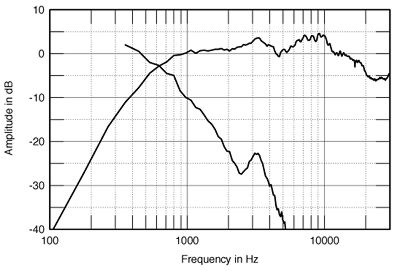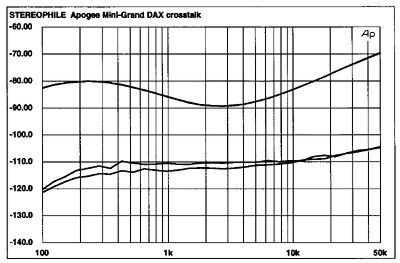Sam Tellig commented on the Stage in March 1991 (Vol.14 No.3):Let me tell you about my friend Lou.
Until recently, Lou rarely hung around with audiophiles. As a result, he's been able to enjoy music and hasn't had to worry much about sound. Actually, his system has been one of the best I've heard—partly because of his superb listening room, with its cathedral ceilings.
Five years ago, Lou bought a pair of Croft OTL mono tube amps from England—still probably the only pair of Croft OTL amps in North America. (Good thing Lou knows how to service his own amps.) He also has a Croft tube preamp and Linn turntable. JA would undoubtedly approve. Ken Kessler surely would. Speakers, until a few months ago, were a pair of Acoustat 2+2s.
Setting the stage
Then Lou heard a pair of Apogee Stages over at the Brass Ear's house and had to have a pair for himself.
The Stages are interesting speakers.
I have heard them sound absolutely wonderful—even at CES, which is quite an accomplishment. I have also heard them sound—well, rather disappointing, at a dealer's and at Stereophile's listening room in Santa Fe, where I thought they sounded their absolute worst. It's true these are twitchy speakers. You need to place them right, use the right cable (Symo) and the right amps.
Lou didn't have the "right" amps, but decided to get the Stages anyway. Remarkably, the pair of Croft OTL tube amps drive the Stages quite well. Bass is not as tight as it might be, and the amps do eventually run out of steam, but the amps are much less problematic than I might have thought.
Even with the Croft OTLs and proper placement, though, Lou was able to make the Stages sound rather steely simply by using the wrong cable, namely, Lars's favorite Purist Audio Design cable, sometimes known as the Texas Cable, or Texas Water Cable. That's right—the cables are filled with water; actually some kind of blue liquid rumored to be poisonous. This could be quite an advantage, because if an audiophile decided he no longer liked his system, he could commit suicide by simply drinking his cables. (No, I don't think the cables are that toxic.)
There's no question that the Apogee-aproved Symo cables resulted in smoother sound than the Texas Water Cables. The water cables sounded...dry. The Symo cables, on the other hand, without the water, sounded more liquid. More detailed, too—rosin in the cellos and that sort of thing.
The fun began when Lou asked me to bring over my new pride-and-yoy B&K M-200 balanced monoblocks. Lou had heard, through the grapevine, that these sounded spectacular in my own system.
"I thought you were going to replace your (unnamed) amp with a new (unnamed) amp," Lou said.
"That was before I got the B&K M-200s. I changed my mind."
"How about bringing them over and putting them on the Stages?"
Much to Lou's later chagrin, I did so. The B&K M-200s were superb on the Stages—better suited than the Croft OTLs. There's more power and tighter, deeper bass. The Crofts, being tube amps, may be slightly more dimensional, but not by much.
"These B&K amps are superb," said Lou. "So transparent."
"We should bring them over to Lars's house and put them on his WATT/Puppies," I suggested.
The Stages are difficult speakers, which makes the performance of the M-200 monoblocks all the more remarkable. Not only is there plenty of power to drive these ribbon loudspeakers, but the sound, with the approved Symo cables, is as smooth as you could want—no hint of hardness.
"I'd better tell Jason Bloom about this. These B&K amps can drive the Stages beautifully and cost no more than the speakers themselves!"
With proper placement, the Symo cables, and the B&K M-200 amps, the Stages truly disappeared—the way that planar speakers can when everything is right. Imaging was excellent and bass was beautifully delineated, even if it didn't go down to the very bottom. The overall tonal balance was superb—which is to say, just right.
I walked behind the speakers and placed my hands on the heatsinks. "Ah, good and hot," I exclaimed. "That's because of the speakers' low impedance and the amps' high bias. Lots of heat—that's the secret to good sound.
"Gad, these amps are magic on the Stages," I carried on.
"And the Stages are magic on the amps," Lou chimed in.
"I'll just have to write another column and tell everyone about this. The speakers and the amps offer amazingly good sound for the money. People don't have to buy Classé or Krell to get good sound from these Apogees. They can get it with B&K. In fact, I don't hear how it could be any better, do you?"
"Well, maybe the Crofts," said Lou. "But I'm amazed by how smooth, detailed, dynamic, and transparent those B&K amps are. I never would have believed."
The B&K M-200 amps were biased high, as I mentioned in a previous column. This gives the amps that "pynchebutt" quality missing when the amps run cold: there's welcome warmth, which is all the M-200s need, in my opinion, to put them in contention against the very best amps available at any price—tube or solid-state.
CD or LP, recording after recording, the amps and the speakers made beautiful music together—never turning shrill, even when we tempted fate with the least promising recordings.
Of course, there was fun to be had along the way. As you know, I'm never happy unless I'm stirring things up. Lou put on the Chesky recording of Pictures at an Exhibition. "I think the Crofts clip on one passage," he said. "Let's see how the B&K amps perform."
"They'll clip, too," I predicted. "Ten to one it's cartridge mistracking that you hear. You should buy a Shure. Linn/Ittok/Shure, that's the combination."
Lou was quite taken aback a few months ago when his brother took my advice, but not Lou's, and bought a Shure.
"Smart move," I said to Lou.
Sure enough, the passage on the Chesky LP came and the stylus couldn't hold the groove. This was on the B&K amps.
"Well, now we know it's not the Crofts."
"It could be the B&K clipping," said Lou tentatively.
"Bull! You heard the way those amps sailed through those CDs with no clipping. That's cartridge mistracking if I ever heard it. I'll be happy to bring over the Shure test records to prove it. This is how John Atkinson ruined a good part of his record collection—low-compliance moving-coils."
Lou is pleased as punch with his Stages, but still not certain if the Crofts are up to driving them. (I think they are, but the B&K amps definitely pack more punch into the Stages, whose impedance is just under 4 ohms, fairly consistent at all frequencies.) The B&Ks win out on the basis of bass control. The Crofts have a slight advantage in terms of dimensionality.
Vertical listening angle
Meanwhile, the Brass Ear has sold his Stages.
"He did what?" I asked incredulously when I heard the news.
"He sold his Stages," my anonymous friend repeated.
Just a few weeks earlier, Brass had been telling the world that the Stages were the best speakers he'd ever had. Now he'd sold them. But don't take this too seriously. Like a lot of audiophiles, Brass sells everything.
I've never visited the Brass home, but I've been told that Brass Ear has this special electric chair. Its place on the floor is carefully marked. The chair is adjustable so it moves up and down. That way, Brass can get the Brass Ears at just the right plane—and he can change the listening plane depending on the recording. This beats readjusting the cartridge VTA. Brass adjusts the height of his ears—vertical listening angle, or VLA!
But Brass has been spending a lot of his time lately chez Lars, listening to the WATT/Puppies. So out went the Stages, in went the WATT/Puppies. Now, apparently, these are the best speakers the Brass Ear has ever heard.
The Brass Ear embarrassed
Here's the thing.
Brass is embarrassed. What will he tell his good buddy, Jason Bloom, of Apogee? (Well, Brass, I think Jason found out within 24 hours, so I'm not the one to spill the beans.) There has been a great deal of secrecy surrounding the Brass Ear's selling of his Stages.
"Psst. Don't tell anyone. You're not supposed to know. The Brass Ear has sold his Stages."
Everyone in the New York area audiophile community knew within hours. The problem is, will the Brass Ear keep his WATT/Puppies long enough to really enjoy them? Or as soon as he has them properly positioned in his listening room, will he turn around and sell them for who knows what?
"I understand that Lars and the Brass Ear fiddled for hours trying to get the Stages to sound just right," said my anonymous tipster friend. "I mean hours. Lars got out his tape measure and positioned the speakers at exact distances from the back and side walls—to the fraction of an inch. Then I hear that Lars measured the distance from the tip of the Brass Ear's nose to each speaker, just to make certain the chair was centered."
"All that work for nothing?" I asked.
"It seems so. I don't know if the Brass Ear actually had much time to listen to the Stages. He was too busy setting them up. Then when he finished setting them up, he put them up for sale."
Audiophile madness. It afflicts everyone—reviewers in particular.—Sam Tellig



 But just because it's the baby in the line and their currently most affordable all-ribbon speaker, it would be a mistake to regard the Stage as a budget model. The level of finish is superb; no corners were cut. And surprisingly, the sound quality does not take a back seat to its more expensive relatives, which should be incredibly good news to most audiophiles.
But just because it's the baby in the line and their currently most affordable all-ribbon speaker, it would be a mistake to regard the Stage as a budget model. The level of finish is superb; no corners were cut. And surprisingly, the sound quality does not take a back seat to its more expensive relatives, which should be incredibly good news to most audiophiles.











 But all of this, and much from Apogee which has followed—striking though some of it may be—was merely a warm-up to the real Apogee: the Grand, which was introduced with much fanfare at the 1991 Summer CES. The Grand, a four-way system with four amps per channel, blew the minds of a bunch of speechless reviewers and other assorted scribes in the very large listening room in which it was being demonstrated. The Grand established two new milestones for Apogee: It was their first flagship loudspeaker to use dynamic cone drivers for subwoofers, and it boasted a numbing price tag which vaulted it into Wilson WAMM and Infinity IRS territory.
But all of this, and much from Apogee which has followed—striking though some of it may be—was merely a warm-up to the real Apogee: the Grand, which was introduced with much fanfare at the 1991 Summer CES. The Grand, a four-way system with four amps per channel, blew the minds of a bunch of speechless reviewers and other assorted scribes in the very large listening room in which it was being demonstrated. The Grand established two new milestones for Apogee: It was their first flagship loudspeaker to use dynamic cone drivers for subwoofers, and it boasted a numbing price tag which vaulted it into Wilson WAMM and Infinity IRS territory.












